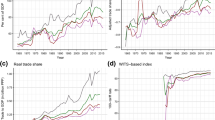Abstract
The purpose of this article is to examine the relationship between the real trade balance and the real exchange rate for bilateral trade in merchandise goods between Singapore, Korea, and Malaysia and the USA and Japan on a quarterly basis over the period 1970 to 1996 using the partial reduced form model of Rose and Yellen (1989) derived from the two-country imperfect substitutes model. With the exception of Korean trade with the USA, and in line with recent work using a similar methodology, our findings suggest that the real exchange rate does not have a significant impact on the real trade balance, and for Singapore and Malaysia we can find no persuasive evidence for J-curves. For Korea, however, the data were consistent with some J-curve effects with respect to both Japan and the USA. Moreover, it is possible that for Korea these effects were being masked or muted by “small” country pricing of exports in foreign currency, but there was no evidence that imports subsequently fell as the lag length on the real exchange rate increased, which would be required to support a strict interpretation of the J-curve.
Similar content being viewed by others
References
Abeysinghe, Tilak and Lin Yeok Tan (1998) ”Exchange Rate Appreciation and Export Competitiveness: The Case of Singapore.” Applied Economics 30:51–55.
Argy, Victor (1994) International Macroeconomics: Theory and Policy. New York: Routledge.
Bahmani-Oskooee, M. (1985) ”Devaluation and the J-Curve: Some Evidence from LDCs.” The Review of Economics and Statistics 67:500–504.
Doornik, Jurgen A. and David F. Hendry (1994) PcFiml 8.0: Interactive Econometric Modelling of Dynamic Systems. Oxford: University of Oxford Institute of Economics and Statistics.
–– (1994) PcGive 8.0: An Interactive Econometric Modelling System. Oxford: University of Oxford Institute of Economics and Statistics.
Goldstein, M. and M.S. Khan (1985) “Income and Price Effects in Foreign Trade.” In R.W. Jones and P.B. Kenen (eds), Handbook of International Economics. Amsterdam: North Holland, 1041–1105.
Hall, B. (1995) Time-Series Processor Version 4.3. Palo Alto, CA: TSP International.
Han-Min Hsing and Andreas Savvides (1996) ”Does a J-Curve Exist for Korea and Taiwan?” Open Economies Review 7:127-145.
Johansen, S. and K. Juselius (1990) “Maximum Likelihood Estimation and Inference on Cointegration.” Oxford Bulletin of Economics and Statistics 52:162–210.
Krugman, Paul (1989) “The J-Curve, the Fire Sale, and the Hard Landing.” The American Economic Review 79:31–35.
Krugman, Paul and Robert E. Baldwin (1987) “The Persistence of the US Trade Deficit.” Brookings Papers on Economic Activity 1-2:1–43.
Krugman, Paul and Maurice Obsfeld (1997) International Economics. Reading, MA: Addison-Wesley.
MacKinnon, James G. (1994) “Approximate Asymptotic Distribution Functions for Unit-Root and Cointegration Tests.” Journal of Business and Economic Statistics: 167–176.
Meese, R.A. and K. Rogoff (1988) “Was it Real?” Journal of Finance 43:933–948.
Menon, Jayant (1995) “Exchange Rate Pass-Through.” Journal of Economic Surveys 9(2):197–231.
Noland, Marcus (1989) “Japanese Trade Elasticities and the J-Curve.” The Review of Economics and Statistics 71:175–179.
Osterwald-Lenum, Michael (1992) “Practitioners' Corner: a Note with Quintiles for the Asymptotic Distribution of the Maximum Likelihood Cointegration Rank Test Statistic.” Oxford Bulletin of Economics and Statistics: 461–471.
Pantula, Sastry G., Graciela Gonzalez-Farias, and Wayne A. Fuller (1994) “A Comparison of UnitRoot Test Criteria.” Journal of Business and Economic Statistics: 449–459.
Phillips, P.C.B. and Pierre Perron (1988) “Testing for a Unit Root in Time-Series Regression.” Biometrika 75:335–346.
Rose, Andrew K. (1990) “Exchange Rates and the Trade Balance.” Economics Letters 34:271–275.
Rose, Andrew K. (1991) “The Role of Exchange Rates in a Popular Model of International Trade: Does the Marshall-Lerner Condition Hold?” Journal of International Economics 30:301–316.
Rose, Andrew K. and Janet L. Yellen (1989) “Is There a J-Curve?” Journal of Monetary Economics 24:53–68.
Sargan, J.D. (1964) “Wages and Prices in the United Kingdom: a Study in Econometric Methodology.” In David F. Hendry and K. F. Wallis (eds.) (1994) Econometrics and Quantitative Economics. Oxford: Basil Blackwell.
Tongzon, Jose L. and Jayant. Menon (1995) “Exchange Rates and Export Pricing in a Small Open NIC: the Singaporean Experience.” The Singapore Economic Review 38(2):201–211.
Author information
Authors and Affiliations
Rights and permissions
About this article
Cite this article
Wilson, P. Exchange Rates and the Trade Balance for Dynamic Asian Economies—Does the J-Curve Exist for Singapore, Malaysia, and Korea?. Open Economies Review 12, 389–413 (2001). https://doi.org/10.1023/A:1017982901034
Issue Date:
DOI: https://doi.org/10.1023/A:1017982901034




